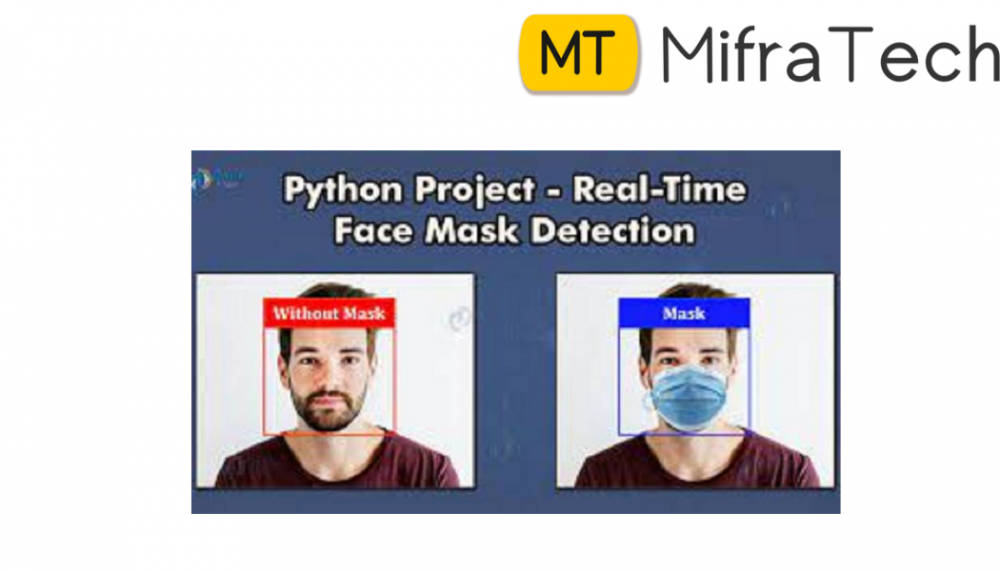
During pandemic COVID-19, WHO has made wearing masks compulsory to protect against this deadly virus. In this tutorial we will develop a machine learning project – Real-time Face Mask Detector with Python.
We will build a real-time system to detect whether the person on the webcam is wearing a mask or not. We will train the face mask detector model using Keras and OpenCV.
Dataset
The dataset we are working on consists of 1376 images with 690 images containing images of people wearing masks and 686 images with people without masks.
Download the dataset: kaggle website
We are going to build this project in two parts. In the first part, we will write a python script using Keras to train face mask detector model. In the second part, we test the results in a real-time webcam using OpenCV.
Make a python file train.py to write the code for training the neural network on our dataset. Follow the steps:
Import all the libraries and modules required.
from keras.optimizers import RMSprop
from keras.preprocessing.image import ImageDataGenerator
import cv2
from keras.models import Sequential
from keras.layers import Conv2D, Input, ZeroPadding2D, BatchNormalization, Activation, MaxPooling2D, Flatten, Dense,Dropout
from keras.models import Model, load_model
from keras.callbacks import TensorBoard, ModelCheckpoint
from sklearn.model_selection import train_test_split
from sklearn.metrics import f1_score
from sklearn.utils import shuffle
import imutils
import numpy as np
This convolution network consists of two pairs of Conv and MaxPool layers to extract features from the dataset. Which is then followed by a Flatten and Dropout layer to convert the data in 1D and ensure overfitting.
And then two Dense layers for classification.
model = Sequential([
Conv2D(100, (3,3), activation='relu', input_shape=(150, 150, 3)),
MaxPooling2D(2,2),
Conv2D(100, (3,3), activation='relu'),
MaxPooling2D(2,2),
Flatten(),
Dropout(0.5),
Dense(50, activation='relu'),
Dense(2, activation='softmax')
])
model.compile(optimizer='adam', loss='binary_crossentropy', metrics=['acc'])
TRAINING_DIR = "./train"
train_datagen = ImageDataGenerator(rescale=1.0/255,
rotation_range=40,
width_shift_range=0.2,
height_shift_range=0.2,
shear_range=0.2,
zoom_range=0.2,
horizontal_flip=True,
fill_mode='nearest')
train_generator = train_datagen.flow_from_directory(TRAINING_DIR,
batch_size=10,
target_size=(150, 150))
VALIDATION_DIR = "./test"
validation_datagen = ImageDataGenerator(rescale=1.0/255)
validation_generator = validation_datagen.flow_from_directory(VALIDATION_DIR,
batch_size=10,
target_size=(150, 150))
checkpoint = ModelCheckpoint('model2-{epoch:03d}.model',monitor='val_loss',verbose=0,save_best_only=True,mode='auto')
history = model.fit_generator(train_generator,
epochs=10,
validation_data=validation_generator,
callbacks=[checkpoint])
project code
import cv2
import numpy as np
from keras.models import load_model
model=load_model("./model-010.h5")
results={0:'without mask',1:'mask'}
GR_dict={0:(0,0,255),1:(0,255,0)}
rect_size = 4
cap = cv2.VideoCapture(0)
haarcascade = cv2.CascadeClassifier('/home/user_name/.local/lib/python3.6/site-packages/cv2/data/haarcascade_frontalface_default.xml')
while True:
(rval, im) = cap.read()
im=cv2.flip(im,1,1)
rerect_size = cv2.resize(im, (im.shape[1] // rect_size, im.shape[0] // rect_size))
faces = haarcascade.detectMultiScale(rerect_size)
for f in faces:
(x, y, w, h) = [v * rect_size for v in f]
face_img = im[y:y+h, x:x+w]
rerect_sized=cv2.resize(face_img,(150,150))
normalized=rerect_sized/255.0
reshaped=np.reshape(normalized,(1,150,150,3))
reshaped = np.vstack([reshaped])
result=model.predict(reshaped)
label=np.argmax(result,axis=1)[0]
cv2.rectangle(im,(x,y),(x+w,y+h),GR_dict[label],2)
cv2.rectangle(im,(x,y-40),(x+w,y),GR_dict[label],-1)
cv2.putText(im, results[label], (x, y-10),cv2.FONT_HERSHEY_SIMPLEX,0.8,(255,255,255),2)
cv2.imshow('LIVE', im)
key = cv2.waitKey(10)
if key == 27:
break
cap.release()
cv2.destroyAllWindows()
In this project, we have developed a deep learning model for face mask detection using Python, Keras, and OpenCV. We developed the face mask detector model for detecting whether person is wearing a mask or not. We have trained the model using Keras with network architecture.
Now we will test the results of face mask detector model using OpenCV.
Note : Find the best solution for software and technical projects ideas